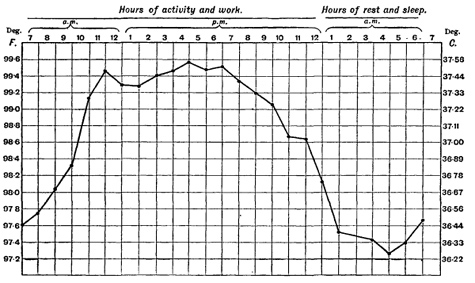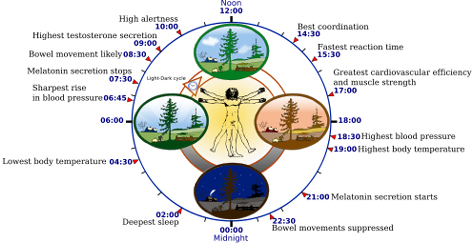The Circadian Rhythm
What Does It Do?
The circadian rhythm shows up most readily in our daily patterns of behavior and activity. That means when we sleep and what time we wake up, when we are most productive and alert, or most sociable, when we get hungry and thirsty, changes in our emotional states, physical and mental endurance, even our level of tolerance for pain.
But these behavior patterns are just the tip of the iceberg. As you peer ever deeper into the inner-workings of the human body, you see that this daily rhythm is present in us down to our very core, observable in every physiological process, across complex bodily systems, all the way down to the biochemical activity of an individual cell.
It can be seen in daily cycles of your body temperature (which varies down to a nighttime low of about 2.3° F under peak daytime temperature), your hormone levels, your metabolism, changes in brainwave activity and the functioning of your immune system. Even your body height varies with the circadian rhythm, as Paul Martin tells us in his book Counting Sheep, since your body settles ever so slightly, when you’re on your feet throughout the day, and stretches back out again at night, when you’re asleep in bed.

The presence of a circadian rhythm in living organisms of all kinds suggests that it was incorporated very early on in evolutionary history. One theory for its origin is that in the earliest primitive life, it would have been advantageous to restrict DNA replication to nighttime hours when the organism would be protected from the harmful effects of daytime ultraviolet radiation.
But it’s not hard to see why it would be an evolutionary advantage for animals to be compelled in their behavior by an inner sense of day and night. When the sun goes down and darkness takes over, the animal world becomes a pretty dangerous place, full of unseen threats and stealthy predators. Unless you are built for a nocturnal schedule, it just doesn’t pay to be out wondering around after dark. The cocoon of sleep (along with the safety and warmth of shelter) is a smart instinctive response to the hazards of nighttime. The same would have been true for us in the days before we graduated from the wild — and may yet be true today.
Looking at the question from a purely physiological perspective, we can see one more reason behind the circadian rhythm: Any complex system, like that of the human body, will tend to work more efficiently if it’s set up to anticipate demands before they happen, rather than just reacting to them as they come along. So you can imagine your body using this innate cycle, keyed to the planetary patterns of day and night, to coordinate all its various systems and functions so that they are primed and ready for peak performance just as they’re needed.

Each day of our lives the circadian rhythm is in force managing things smoothly and seamlessly from behind the scenes. In the morning hours, it works to ensure that our bodies are up and ready to go, optimized for alertness and activity. Throughout the day, it encourages us to pace ourselves by modulating our energy levels, strength and endurance. And it keeps us fueled up by governing our appetite and cycles of digestion. At the end of the day, before we are even thinking of bedtime, it begins to slow down the body’s metabolism in preparation for sleep. Once we are asleep, it is still at work regulating the release of growth hormones so that the body can heal and regenerate itself. And in the last final hours of sleep, it releases other hormones to prepare us for the moment of waking.
